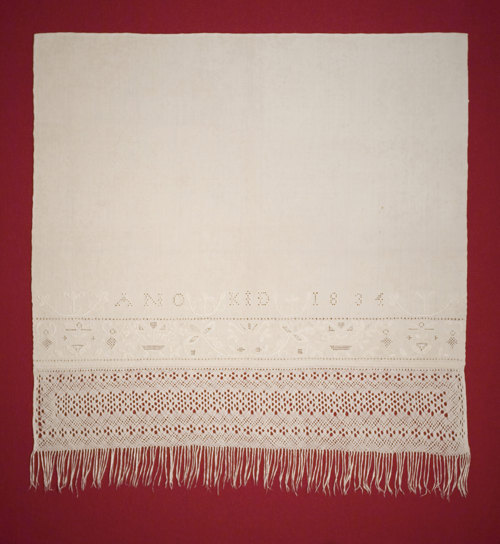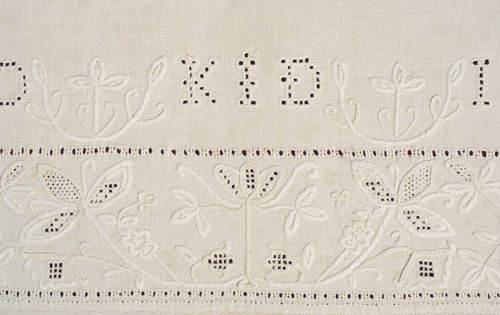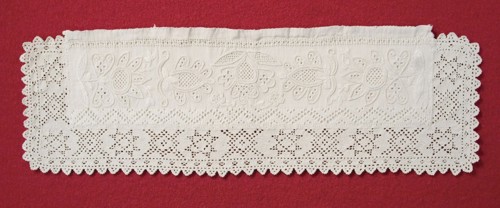"Hvidsøm"
Here on this page, you will find examples of textiles that incorporate the "hvidsøm" embroidery technique.

Shirt with ”Hvidsøm” on the collar, shoulder and sleeves
The ”Hvidsøm” is sewn on a separate piece of fabric and afterwards attached to the shirt. There are small areas of square cut work and cross stitching. The cuffs are embroidered with fillings where threads have been laid on top of the fabric instead of being drawn out as in ”Hvidsøm” fillings. The cuffs are finished in Hedebo edge with dense rows of Danish buttonhole stitch. On the shoulders there are squares, which look like square cut work, both in the small flower and between the two large flowers. Actually this is needle weaving as used in Baldyring”.
Please note
- The rich embroidery on the reverse side of the collar, which suggests an upturned collar
- The small, closely wrinkled pieces held in place by chain stitching and smocking in the area from the embroidered shoulder pieces to the collar
- The four-sided stitching along the edge of the front opening, which continues round the bottom of the opening, and is embroidered with needle lace in buttonhole stitch
- The monogram sewn with red cross stitch in shifting directions





Decorative towel with square cut work and counted thread work
The decorative towel is interesting because it contains nascent ”Hvidsøm”, in which the needlewoman has not yet started to use entwined shapes. The patterns are plain and geometrical. The upper border contains experimental ”Hvidsøm”. The other borders consist of geometrical patterns, flower arrangements, and birds in square cut work and counted thread work . In the border below the initials, stars are embroidered with counted thread work. The initials AHD are sewn in cross stitch and refer to Ane Hansdatter (the daughter of Hans) from Kildebrønde. She was born in 1820.
Please note
- The main borders are surrounded by different sets of darning hem stitch, with rows of square stitching on both sides
- The pattern in the upper border consisting of stars in square cut work placed in diagonal lines, forming large square areas. Inside the squares, flowers are embroidered with square cut work and ”Hvidsøm”. Outside the squares, there are flower arrangements in ”Hvidsøm”
- The bought fringes attached at the bottom






Decorative towel with "baldyring", "hvidsøm", square cut work
The decorative towel shows a rare mixture of the variations in square cut work: ”Hvidsøm”, and ”Baldyring” . The embroidery, filled with interesting details, spreads over a large part of the middle section. It is divided into five borders separated by ten rows of H hemstitching. The borders above and below the border with the monogram, contain ”Hvidsøm” fillings and ”Baldyring” fillings, as well as square cut work. All of it is surrounded by vines, with leaves sewn in outline stitch and satin stitch. The decorative towel consists of four parts. The embroidered part has been lengthened, both at the top and the bottom, by a piece of plain material. A piece of linen with a plaited warp has also been attached to the bottom.
Please note
- Inside the vase in the middle of the bottom border, a relatively rare ”Hvidsøm” filling: needle weaving including cross bars of threads
- The monogram sewn into the border with plain square cut work The monogram itself resembles drawn thread work
- The tulips in all the wide borders




”Knædug” with ”Hvidsøm” and square cut work
The embroidery consists of a wide border tightly filled with patterns worthy of close study. The motif is a large central flower with vines and leaves. A flower arrangement is on each side. The petals and leaves of the flower are filled with different “hvidsøms” fillings.The initials MHD are embroidered in square cut work and refer presumably to Mette Hansdatter as the needlewoman. She was born around 1798 in Hastrup, and gave birth to her daughter, Mette Olsdatter, in 1830. Her daughter’s initials (MOD) are embroidered into her mothers ”knædug”. At the beginning of the 20th century the daughter was visited by museum keeper Elna Mygdal, who collected Hedebo textiles for the Danish Folk Museum.
Please note
- The large oval holes at the top of the leaves in the two large flowers sewn on the outermost edges
- How square cut work is used in the branches and leaves
- The two squares at the bottom filled with square cut work as well as with Hvidsøm” filling, and finished with blanket stitch in the centre and at the edges
- The bought fringe attached to the ”knædug”




Decorative towel with ”Hvidsøm” and square cut work
The towel consist of three borders;, the two lowest are made of the same fabric while the upper one is of a finer fabric. All three parts must have been embroidered by the same needlewoman because of the regularity of the stitching e.g. the way the chain stitches meet each other in the curvy forms and the repetitive ”Hvidsøm” filling. What cannot be shown in this exhibition is the regularity on the reverse side.
Please note
- That the H hemstitching on the upper piece, and the double row of square stitching with drawn threads on the lower piece, have almost the same appearance
- How the needlewoman did not try to hide the joins in the fabric
- How the fillings in the centre border are embroidered around the flower leaves, and not inside them
- The herringbone stitching between the two rows of chain stitch on the edge of the rosettes in the upper piece, which is repeated in the wavy lines on the two narrow borders, and on the edges of the two flowers at the sides of the lower border



Decorative towel with ”Hvidsøm”
The decorative towel is atypical because of the replacement of the chain stitching which usually surrounds the ”Hvidsøm” fillings by outline stitch and satin stitch, sewn with a thick thread which makes the embroidery look French. Also, the shape of the ”Hvidsøm” fillings in the three central motifs in the three upper borders, and in the lowest border, is significantly different from the smaller motifs and the more traditional flowers and pomegranates of the whole middle section.
Please note
- How counted thread work and satin stitch are used for the flowers in some of the large ”Hvidsøm” fillings
- The three large areas framed by four and two rows of H hemstitch, which calm the otherwise voluptuous embroidery
- A bought fringe in the form of open lace made of loosely woven spun cotton which has been attached to the bottom
- The monograms embroidered in square cut work refer to mother and son, that is, Ane Nielddatter born in 1813, and her son Niels Olsen, born in 1836




"Knædug" with "baldyring", square cut work, counted thread work and "hvidsøm"
The satin stitch bases are evenly spread over the canvas and bordered with tendrils and leaves in flat stitch. The fillings in the satin stitch bases are simple, consisting primarily of arches, points, and openwork. At the top, remnants of the monogram AADD can be glimpsed. The two leaves above the initials, unlike the rest of the embroidery, are filled with a whitework base. Below, before the warp plaiting, a border with square-cut embroidery featuring deer and stylized trees of life is visible.
Please note
- Two of the square bases in the top border and four in the bottom border are embroidered with cutwork Hedebo
- The bottom border, with square-cut embroidery, H-hole stitches, and warp plaiting, is of a different fabric quality
- The embroidered tendrils and leaves are executed with great embroidery skill, whereas many of the satin stitch bases lack this level of expertise
- The area with the monogram is worn thin, suggesting that old monograms may have been removed and new ones added





Collar with ”Hvidsøm” and square cut work unpicked from a shift
The flowers are embroidered with single or double rows of chain stitch and filled with crossstitching or square cut work fillings. In the centre, two small flowers embroidered in blanket stitch and chain stitch can be seen. The wide lace is embroidered with dense rows of Danish buttonhole stitching. Between the stitches are small holes creating stars and squared patterns. The collar’s shape and embroidery suggest that it was made in the decade 1810-1820. The collar is characteristic of ”Hvidsøm” and was made by a very skilled needlewoman.
Please note
- The woven hem stitch and its barely visible perforated pattern caused by the collar being made of two layers of fabric
- The vertical lace along the collar’s ends was embroidered first, the horizontal lace last. Then a narrow Hedebo edge was embroidered around the whole collar
- How neatly the lace towards the neck finishes exactly at the edge of the upper hemstitch
- The embroidered ”Hvidsøm” flowers in the corners of the collar’s reverse side which are supplemented by “the chain” along its entire length



”Hvidsøm” collar with a Hedebo edge
The collar was unpicked from a shift. The ”Hvidsøm” embroidery is divided into two parallel borders with a narrow chain of hemstitch in between. In this piece, fillings in the outermost flowers are sewn on the fabric, instead of being in the drawn fabric. All other fillings are made by drawing threads and embroidering cross-stitching over the remaining threads. In the lower narrow border, the flowers are embroidered in satin stitch, outline stitch, and chain stitch without fillings. The Hedebo edge is very tight and firm. It is embroidered with Danish buttonhole stitching in long rows with squared holes, which form the pattern. The collar is a typical example of a collar from around 1815 embroidered by an experienced needlewoman.
Please note
- The three rows of chain hemstitching are parallel to each other and do not continue along the collar’s ends
- The corner motif in ”Hvidsøm” on the reverse side has additional chain hemstitch, just enough to cover the width of the corner embroidery
- The small chain stitch flowers at the centre of the narrow border’s eight-leafed flowers
- The tulip motif in the narrow embroidered border



Post pieces with ”Hvidsøm” and square cut work
Post pieces were always found in pairs and were attached to the wooden columns on each side of the door of a small wall cupboard by red silk ribbons. They are unique to the Hedebo area. The two pieces are alike except for the monogram and date. At the top, a Hedebo edge is finished with points and picots. The monogram is made in square cut work. The centre border contains typical flower motifs with ”Hvidsøm” fillings, surrounded by two rows of chain stitching. At the bottom, a bought fringe has been attached.
Please note
- The very beautiful satin stitch
- The needlewoman must have been irritated that the monogram’s ‘G’ did not turn out well
- The fabric inside the numbers and letters is the same, except for three of the spaces in the vertical lines in the numbers and letters, which are filled with whip stitching
- The needlewoman has tried to create ‘life’ in the large flower in the upper ”Hvidsøm” pattern by adding both weaving stitch and drawn thread stitch to the three upper leaves, while the two lower leaves are merely embroidered with drawn thread stitching
